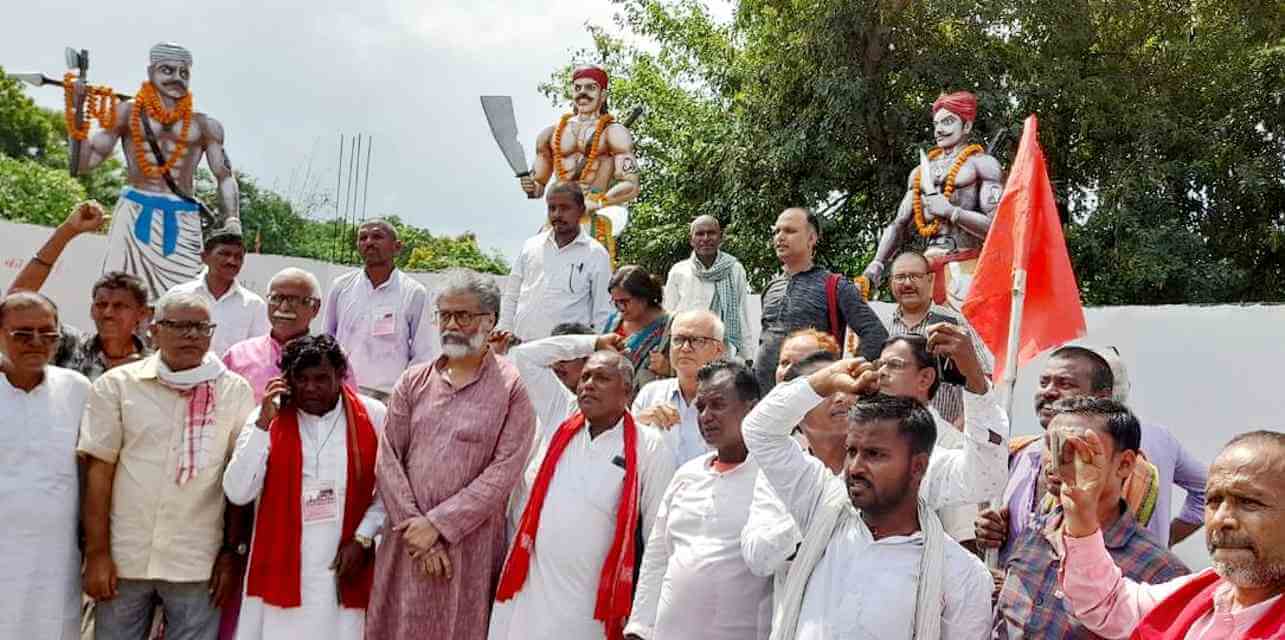Commemoration of Rajwar Revolt of 1857 in Nawada

During 1857 war of independence the Rajwar revolt in the hills of Nawada in Bihar continued for almost ten years. In commemoration of the heroes of this historic battle – Jawahir Rajwar, Aetawa Rajwar and Karu Rajwar – and for constructing their memorial a mass meeting was organised on 21 Sep. 22 in Sitamarhi of Nawada district.
The meeting was addressed by CPIML General Secretary Dipankar Bhattacharya and attended by thousands of people from nearby villages and towns. A pledge was taken to preserve the memory of those martyrs by erecting a national memorial at Sitamarhi (Nawada), by including life sketches of the heroes of this war of independence in school text books, to increase awareness about our history of freedom struggles and to commit ourselves for today’s struggle to fulfil the yet unfulfilled dreams of the martyrs.
Comrade Dipankar said that real tributes can be paid to the martyrs by carrying forward their ideas, dreams and struggles forward. Those in the seat of power in India today are the people who never were part of India’s freedom movement and are now trying to subvert equality, freedom and fraternity which had been the fundamental tenets of freedom struggle. Shaheed-e-Azam Bhagat Singh had warned us of brown Angrez, and we have to struggle against such forces now for an India of martyrs’ dreams, for freedom and equality for all.
The participation of the common people, especially the lowest sections, in the 1857 revolution against oppression, loot and slavery is gradually starting to unfold, but some pages remain yet unread. The most important of these is the Rajwar rebellion in Bihar which has so far appeared only as a footnote in history books. This was the first dalit revolt in Bihar and possibly the biggest till date. The rebellion which started in 1857 continued for the next ten years. By 1859, the struggle of 1857 in other parts of the country had either run out of steam or suffered defeat, but the Rajwar rebellion continued relentlessly. This struggle was fought in former Gaya District's Nawada and the hills of Nalanda. At one time, the Rajwars had even succeeded in wiping out the British from the region. Rajauli was the main centre of the struggle, where not only the British, but also the zamindars were given a tough fight.
Sitamarhi was the epicentre of the little known Rajwar revolt which kept the flames of 1857 alive till 1867. One of the key leaders Jawahir Rajwar was killed by the British rulers on 28 September, 1857, but his comrades Etwa Rajwar, Karu Rajwar, Bhokta Rajwar and others continued the battle for another ten years. The British rulers could never capture Etwa Rajwar.
Comrade Dipankar further noted that the Rajwar revolt witnessed a broader unity of Dalits and oppressed people from other communities too and triggered a wider social awakening in today's Gaya-Nawada-Nalanda region. The revolt still remains largely ignored in official history narratives and the heroes like Jawahair Rajwar, Etwa Rajwar and Karu Rajwar, though greatly revered by the local people are yet to get any recognition from the governments in Patna and Delhi.
The commemoration event was also addressed by CPIML Bihar secretary Kunal, senior leaders Amar, Rambali Yadav, Arwal MLA Mahanand Singh, and more than a dozen activists and leaders from the Ranjvanshi community.
The speakers pledged to carry forward the spirit of Freedom75 campaign and dreams of the martyrs. Nawada District panchayat president Pushpa Rajavanshi, Vijay Rajvanshi, Pradeep Rajavanshi and others also spoke at the meetings which was presided by CPIML leader Mevalal Rajavanshi and conducted by Bhola Ram.
Charu Bhawan, U-90, Shakarpur, Delhi 110092
Phone: +91-11-42785864 | +91 9717274961 E-mail: info@cpiml.org

